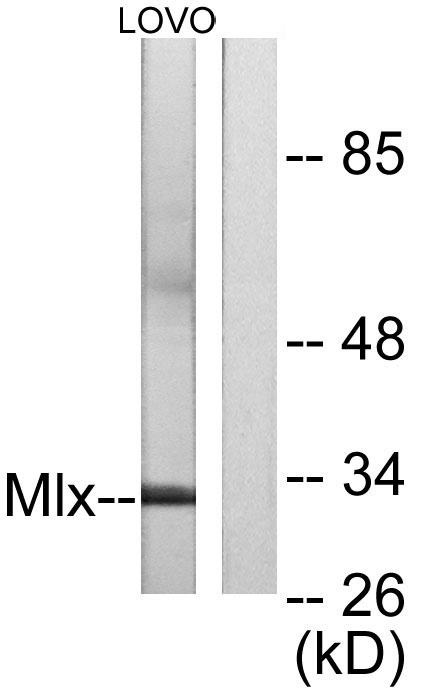Mlx Polyclonal Antibody
- Catalog No.:YT2791
- Applications:WB;IHC;IF;ELISA
- Reactivity:Human;Mouse;Rat
- Target:
- Mlx
- Fields:
- >>Insulin resistance;>>Non-alcoholic fatty liver disease
- Gene Name:
- MLX
- Protein Name:
- Max-like protein X
- Human Gene Id:
- 6945
- Human Swiss Prot No:
- Q9UH92
- Mouse Gene Id:
- 21428
- Mouse Swiss Prot No:
- O08609
- Immunogen:
- The antiserum was produced against synthesized peptide derived from human Mlx. AA range:111-160
- Specificity:
- Mlx Polyclonal Antibody detects endogenous levels of Mlx protein.
- Formulation:
- Liquid in PBS containing 50% glycerol, 0.5% BSA and 0.02% sodium azide.
- Source:
- Polyclonal, Rabbit,IgG
- Dilution:
- WB 1:500 - 1:2000. IHC 1:100 - 1:300. ELISA: 1:10000.. IF 1:50-200
- Purification:
- The antibody was affinity-purified from rabbit antiserum by affinity-chromatography using epitope-specific immunogen.
- Concentration:
- 1 mg/ml
- Storage Stability:
- -15°C to -25°C/1 year(Do not lower than -25°C)
- Other Name:
- MLX;BHLHD13;TCFL4;Max-like protein X;Class D basic helix-loop-helix protein 13;bHLHd13;Max-like bHLHZip protein;Protein BigMax;Transcription factor-like protein 4
- Observed Band(KD):
- 33kD
- Background:
- The product of this gene belongs to the family of basic helix-loop-helix leucine zipper (bHLH-Zip) transcription factors. These factors form heterodimers with Mad proteins and play a role in proliferation, determination and differentiation. This gene product may act to diversify Mad family function by its restricted association with a subset of the Mad family of transcriptional repressors, namely, Mad1 and Mad4. Alternatively spliced transcript variants encoding different isoforms have been identified for this gene. [provided by RefSeq, Jul 2008],
- Function:
- function:Transcription regulator. Forms a sequence-specific DNA-binding protein complex with MAD1, MAD4, MNT, WBSCR14 and MLXIP which recognizes the core sequence 5'-CACGTG-3'. The TCFL4-MAD1, TCFL4-MAD4, TCFL4-WBSCR14 complexes are transcriptional repressors. Plays a role in transcriptional activation of glycolytic target genes. Involved in glucose-responsive gene regulation.,similarity:Contains 1 basic helix-loop-helix (bHLH) domain.,subcellular location:Found predominantly in the cytoplasm.,subcellular location:Found predominantly in the nucleus.,subunit:Efficient DNA binding requires dimerization with another bHLH protein. Binds DNA as a heterodimer with MAD1, MAD4, MNT, WBSCR14 and MLXIP. Can also bind DNA as a homodimer.,tissue specificity:Expressed in all tissues tested, including spleen, thymus, prostate, ovary, intestine, colon, peripheral blood leukocyte, heart, liver, skeletal
- Subcellular Location:
- [Isoform Alpha]: Cytoplasm . Found predominantly in the cytoplasm (PubMed:10918583). .; [Isoform Beta]: Cytoplasm . Found predominantly in the cytoplasm (PubMed:10918583). .; [Isoform Gamma]: Nucleus . Found predominantly in the nucleus (PubMed:10918583). .
- Expression:
- Expressed in all tissues tested, including spleen, thymus, prostate, ovary, intestine, colon, peripheral blood leukocyte, heart, liver, skeletal muscle and kidney. Lower levels of expression in testis, brain, placenta and lung.
- June 19-2018
- WESTERN IMMUNOBLOTTING PROTOCOL
- June 19-2018
- IMMUNOHISTOCHEMISTRY-PARAFFIN PROTOCOL
- June 19-2018
- IMMUNOFLUORESCENCE PROTOCOL
- September 08-2020
- FLOW-CYTOMEYRT-PROTOCOL
- May 20-2022
- Cell-Based ELISA│解您多样本WB检测之困扰
- July 13-2018
- CELL-BASED-ELISA-PROTOCOL-FOR-ACETYL-PROTEIN
- July 13-2018
- CELL-BASED-ELISA-PROTOCOL-FOR-PHOSPHO-PROTEIN
- July 13-2018
- Antibody-FAQs
- Products Images

- Immunohistochemical analysis of paraffin-embedded Human brain. Antibody was diluted at 1:100(4° overnight). High-pressure and temperature Tris-EDTA,pH8.0 was used for antigen retrieval. Negetive contrl (right) obtaned from antibody was pre-absorbed by immunogen peptide.

- Western blot analysis of lysates from LOVO cells, using Mlx Antibody. The lane on the right is blocked with the synthesized peptide.



